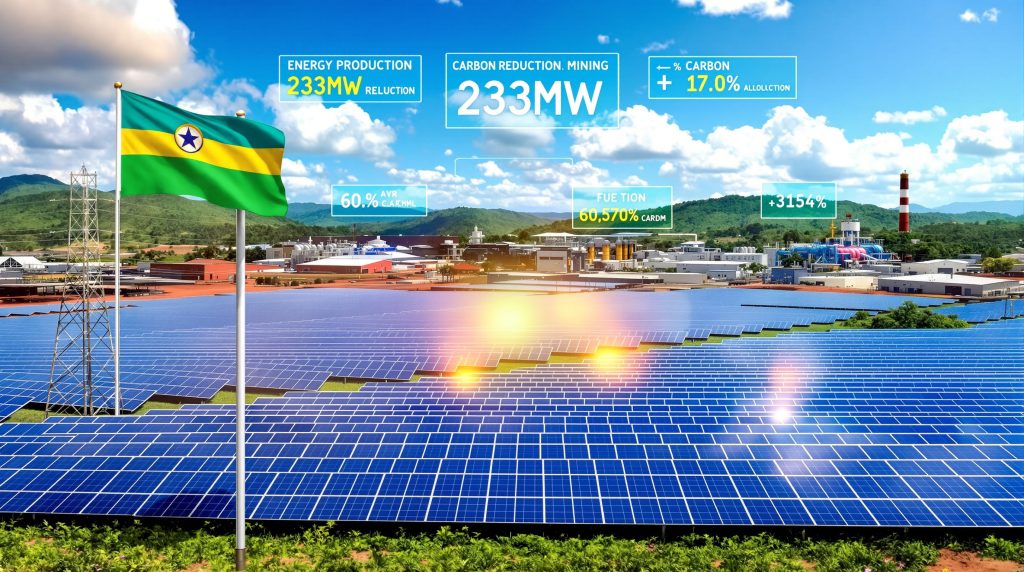Understanding the Significance of Solar Power in DRC's Mining Sector
The Democratic Republic of Congo (DRC) is witnessing a transformative shift in its energy landscape with the development of a 233 MW solar photovoltaic (PV) plant. This renewable energy project represents a crucial step toward addressing the country's energy challenges while supporting its vital mining sector, which forms the backbone of the national economy.
The DRC faces substantial electricity access challenges with only approximately 19% of the population having reliable power access. This stark statistic underscores the critical need for expanded energy infrastructure. Despite being home to vast mineral resources that power the global economy, the country's mining operations have historically relied heavily on diesel generators and limited grid connections, creating both environmental concerns and operational inefficiencies.
Why Solar Power Matters in the DRC Context
Solar energy offers a particularly compelling solution for the DRC's mining sector for several reasons. The country's geographical position near the equator provides consistent solar irradiation throughout the year, making it an ideal location for solar power generation. Additionally, the modular nature of solar installations allows for strategic deployment directly at mining sites, reducing transmission losses and infrastructure requirements.
For mining operations specifically, solar power addresses multiple pain points simultaneously. It reduces exposure to volatile diesel prices, decreases carbon emissions, and improves energy security by diversifying supply sources. The economic case becomes even stronger as solar technology costs continue to decline while diesel prices face long-term upward pressure due to global energy transition trends and carbon taxation trends.
What Makes the 233 MW Sungrow-CrossBoundary Project Revolutionary?
The scale and innovative approach of this solar project position it as a landmark development for both the DRC and the broader African mining sector. By addressing both technical and operational challenges unique to the region, the project establishes a new model for industrial-scale renewable energy solutions integration.
Project Scale and Implementation Timeline
Renewable energy project developer Sungrow is constructing a 233 MW solar PV plant for CrossBoundary Energy, a commercial and industrial energy investment company with significant experience in African markets. According to project documentation, the components are currently being transported to the site, with commercial operation expected to begin in 2026.
The ambitious timeline reflects growing confidence in the technical and economic viability of large-scale solar projects serving industrial clients in challenging environments. This represents a significant evolution from earlier, smaller pilot projects that characterized the first wave of mining sector solar adoption across Africa.
Technical Specifications and Design Innovations
The solar facility incorporates Sungrow's advanced string inverters integrated with medium-voltage systems specifically designed to withstand the DRC's challenging environmental conditions. These technical adaptations include:
- Humidity resistance technology to maintain performance during wet seasons
- Rainfall protection features that safeguard sensitive electrical components
- Heat stress mitigation systems that prevent efficiency losses during peak temperatures
- Simplified maintenance requirements designed for local technical capabilities
This technical approach ensures reliable power generation despite the region's demanding climate while simplifying operations and maintenance requirements for the local team. The string solution design enables more efficient oversight and reduces the technical expertise needed from in-house maintenance staff.
Energy Production and Environmental Impact
Once operational, the facility will deliver approximately 300,000 MWh of clean energy annually. This substantial power generation will:
- Significantly reduce reliance on diesel generators at mining operations
- Cut carbon emissions from energy-intensive extraction processes
- Provide consistent, renewable power for industrial processes
- Establish a sustainable energy blueprint for other mining operations
The environmental benefits extend beyond carbon reduction to include decreased air pollution, reduced noise from diesel generators, and elimination of fuel transportation and storage risks.
How Will the Kamoa-Kakula Copper Complex Benefit?
The integration of solar power at one of Africa's most significant copper mining operations represents a strategic shift with both operational and environmental advantages. The Kamoa-Kakula complex serves as an ideal test case for large-scale renewable integration in mining.
Mining Operations Enhancement
The Kamoa-Kakula Copper mining complex, with its impressive 600,000 tonnes per year production capacity, will be the primary beneficiary of this clean energy source. The integration of solar power into mining operations represents a strategic shift toward sustainable mining practices while addressing operational challenges.
The mining complex's energy-intensive processes—from extraction to processing—will benefit from more stable power supply, reducing production interruptions caused by fuel shortages or power fluctuations. This stability directly contributes to operational efficiency and production reliability, key metrics for mining economics.
Economic Advantages of Solar Integration
The project offers several economic benefits for mining operations:
- Reduced fuel costs: Decreased diesel consumption translates to direct operational savings
- Lower operational expenses: Maintenance and logistics costs associated with diesel generators will decline
- Enhanced energy security: Diversified supply protects against fuel delivery disruptions
- Protection against price volatility: Solar power provides predictable energy costs independent of fuel market fluctuations
- Improved sustainability metrics: Lower carbon footprint enhances market position and investor relations
The economic case becomes particularly compelling when considering the long-term nature of mining investments. While diesel generators require continuous fuel inputs with unpredictable future costs, solar installations represent primarily upfront capital investments with minimal operational expenses over their 25+ year lifespan.
What Technical Approaches Ensure Project Success?
The project's technical design and implementation strategy address the unique challenges of deploying advanced energy technology in a remote mining environment. Several innovative approaches contribute to the project's feasibility and anticipated success.
Innovative Construction and Commissioning Strategies
Sungrow is implementing a pre-installation and pre-commissioning design approach that significantly streamlines project execution:
- Factory-level integration testing reduces on-site troubleshooting requirements
- Modular component design enables faster installation with less specialized labor
- Pre-configured systems minimize complex field adjustments
- Standardized connection interfaces simplify integration with existing infrastructure
This approach accelerates grid connection timelines, reduces overall project delivery time, and enables earlier commissioning benefits for the independent power producer. By front-loading technical challenges into controlled environments, the strategy mitigates execution risks in the more challenging field conditions.
Strategic Partnership Structure
The project features a collaborative implementation model leveraging specialized expertise:
- Sungrow: Providing core technology and system design optimized for local conditions
- Soventix: Serving as the engineering, procurement, and construction contractor
- CrossBoundary Energy: Managing the power purchase agreement and commercial structure
This approach leverages each partner's strengths while ensuring efficient project execution. The combination of international technical expertise with regional operational experience creates a balanced team equipped to navigate both technical challenges and local operating conditions.
How Does This Project Fit Into DRC's Broader Energy Landscape?
The 233 MW solar installation represents more than just a single power project—it serves as a potential catalyst for broader energy system transformation within the DRC. By demonstrating the viability of renewable energy at scale, the project could accelerate the country's overall energy transition.
Current Energy Challenges in DRC
The DRC's energy infrastructure faces several challenges that limit economic development:
- Limited grid coverage reaches only 19% of the population
- Heavy dependence on hydropower subject to seasonal variations and climate change impacts
- Insufficient generation capacity to meet growing industrial and residential demand
- Remote mining operations disconnected from centralized power infrastructure
- Logistical difficulties in fuel transportation to isolated sites
These challenges create a context where decentralized renewable solutions like solar power offer particular advantages, especially for energy-intensive industries operating in remote areas.
Strategic Importance for National Development
For the DRC, where electricity access remains limited, this project represents a significant step toward:
- Green industrialization in the mining sector
- Strengthening the backbone of the country's economy through reliable energy
- Creating a model for future renewable energy integration in industrial applications
- Demonstrating the viability of large-scale solar for industrial applications
- Potential expansion of energy access to surrounding communities
The project aligns with national development goals of increasing electricity access while supporting the mining sector that generates critical export revenue and employment opportunities.
What Broader Trends Does This Project Represent?
The DRC solar project exemplifies several important trends reshaping the intersection of mining and energy systems globally. These trends suggest a fundamental transformation in how resource extraction industries approach their energy needs.
Mining Sector's Renewable Energy Transition
The 233 MW solar project exemplifies a growing trend in the global mining industry:
- Increasing adoption of renewable energy solutions driven by both economics and sustainability goals
- Strategic moves toward carbon footprint reduction in response to investor and regulatory pressure
- Integration of sustainable practices in resource extraction to improve social license to operate
- Balancing economic and environmental considerations through innovative technical solutions
- Decentralization of energy production to enhance security of supply
This evolution represents a significant departure from traditional mining energy strategies that prioritized diesel generators and grid connections when available. The new approach treats energy as a strategic asset worthy of long-term investment and innovation.
Replicable Model for Other Mining Regions
This project establishes a blueprint that could be replicated across:
- Other mining operations in the DRC's copper belt
- Similar mining contexts in sub-Saharan Africa facing energy constraints
- Resource extraction industries globally seeking sustainable energy solutions
- Industrial operations in regions with limited grid infrastructure
- Commercial applications requiring reliable power independent of grid stability
The modular nature of solar technology means successful implementations can be scaled up or down according to specific site requirements, making lessons from this project broadly applicable across different contexts.
What Future Developments Might Follow?
The successful implementation of this pioneering project could catalyze further innovations in mining energy systems throughout the region. Several potential follow-on developments merit consideration.
Potential Expansion and Integration Opportunities
The successful implementation of this solar plant could lead to:
- Additional renewable capacity development as economics are proven
- Integration with energy storage systems to increase dispatchability
- Hybrid power solutions combining solar with other renewable sources
- Potential community electrification initiatives leveraging excess capacity
- Expanded mini-grid systems connecting mining operations with nearby communities
The modular nature of solar installations allows for phased expansion as confidence grows and economics improve. This scalability provides significant flexibility for adapting to changing energy needs over time.
Regional Energy Market Implications
Beyond the immediate mining application, this project could influence:
- Regional power trading dynamics as new generation capacity comes online
- Cross-border energy cooperation possibilities within the Southern African Power Pool
- Development of additional renewable energy infrastructure following proven models
- Strengthening of the DRC's position as an energy producer beyond hydropower
- Potential acceleration of policy frameworks supporting decarbonisation in mining
By demonstrating commercial viability, the project could attract additional investment into the DRC's renewable energy sector, creating positive feedback loops of technology adoption and cost reduction.
FAQ: Key Questions About the DRC Solar PV Project
How does solar power reliability compare to traditional power sources for mining operations?
Modern solar PV systems with proper design and maintenance can achieve 99%+ availability rates, comparable to traditional power sources but without fuel supply chain vulnerabilities. The Sungrow system's specific design for DRC's climate conditions ensures consistent performance even during challenging weather patterns.
While solar generation is limited to daylight hours, this aligns well with peak mining operations. For 24/7 operations, solar power typically integrates with existing power systems rather than completely replacing them, creating a reliable hybrid approach that optimizes each energy source.
What happens to mining operations during nighttime or cloudy periods?
The solar facility will likely operate alongside existing power infrastructure in a complementary manner. During periods of low solar generation, traditional power sources can supplement energy needs, creating a reliable hybrid system that optimizes renewable usage while maintaining operational continuity.
This approach gradually reduces diesel consumption without compromising reliability. As the project matures, energy storage solutions could be added to further increase the solar component's contribution to round-the-clock operations.
How does this project compare to other renewable energy initiatives in African mining?
This 233 MW project represents one of the largest dedicated mining solar installations in Africa, demonstrating exceptional scale and commitment to renewable integration. Similar projects exist across the continent, but few match the capacity and direct industrial application of this installation.
Notable comparisons include the 40 MW solar facility at B2Gold's Fekola mine in Mali and the 7.5 MW solar plant at Iamgold's Essakane mine in Burkina Faso. The DRC project's scale represents a significant advancement in mining innovation trends within the African mining sector.
What environmental benefits will the solar plant provide beyond carbon reduction?
Beyond carbon emissions reduction, the solar plant will significantly decrease local air pollution, reduce noise pollution from diesel generators, eliminate risks of fuel spills, and minimize water usage compared to thermal power generation, creating multiple environmental advantages.
The project also reduces heavy vehicle traffic associated with diesel delivery, decreasing road damage, dust, and transportation emissions. These combined benefits improve both environmental conditions and community relations around mining operations.
Ready to Discover the Next Major Mining Opportunity?
Receive instant alerts on significant ASX mineral discoveries with Discovery Alert's proprietary Discovery IQ model, transforming complex data into actionable insights. Understand why major discoveries lead to substantial market returns by exploring Discovery Alert's dedicated discoveries page and begin your 30-day free trial to position yourself ahead of the market.




